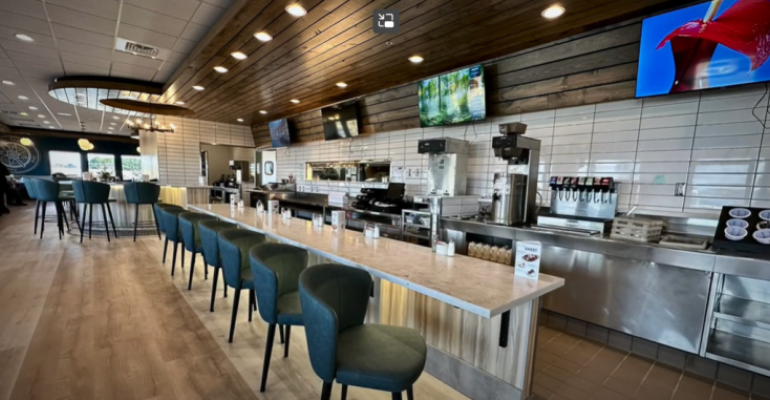Something caught my eye while I was recently traveling to visit my family near Toledo, Ohio. It was rather subtle signage for a full-service restaurant inside of a Petro Stopping Center. I had never heard of this Fork & Compass, but since I was fueling up nearby, I thought the menu was worth checking out.
And that menu is robust – everything from breakfast combos to yogurt parfaits to burgers to shrimp tacos to pork nachos. There are sides and a mac and cheese bar and desserts, including a cheesecake from The Cheesecake Factory Bakery.
As it turns out, this Fork & Compass is a new, proprietary restaurant created by parent company TravelCenters for America. Though the truck stop is no stranger to the restaurant space – operating over 450 quick-service and over 150 full-service brands within its sites – it does seem as though the company is intentionally beefing up its presence in the space. In March, for instance, the company hired Chef Maira Isabel to “reinvent food offerings at the company’s stores,” which include TA, Petro Stopping Centers and TA Express. In addition to Fork & Compass, Isabel will focus on “adding healthy offerings and integrating food trends and regional specialties” into the company’s other proprietary restaurants – Country Pride and Iron Skillet.
The timing here probably isn't coincidental; in February, BP acquired TravelCenters for $1.3 billion, diversifying the fuel giant’s business and bolstering shareholder value. There are plenty of advantages such diversified businesses have. For starters, they attract a captive audience, one that may need more than just food but also fuel, snacks, cigarettes, toiletries, lottery tickets, name it. Because of this steady stream of customers, those restaurant businesses create a “stable, predictable cash flow and mitigate risk,” as TravelCenters’ CEO Jon Pertchik said during the company’s Q3 earnings all in November.
That said, TravelCenters of America is certainly not the only convenience store focused on winning the fierce share-of-stomach competition. Last month, Sunshine Gasoline Distributors, in partnership with Rego Restaurant Group, opened a dual-branded Taco Del Mar and Quiznos at one of its c-stores in Florida, for instance. At least 13 such co-branded restaurants are expected to open inside Sunshine c-store locations around Florida. Further, Love’s recently announced it is growing its partnership with Bojangles with a franchise development agreement that includes 40 new restaurants inside Love’s Travel Stops in four new states.
On the proprietary side, Cumberland Farms recently opened its second Ria’s Pizzeria with “many” more coming, according to parent company EG Group. 7-Eleven – the largest c-store chain in the country – launched a new, and fast-growing, Evolution Store prototype in 2019 along with new restaurants like Raise the Roost Chicken and Biscuits and Parlor Pizza.
Indeed, TravelCenters also isn’t the only c-store chain stepping up its foodservice offerings. At the end of 2022, Kum & Go launched a new menu featuring healthier foods such as quinoa bowls, for instance, while Wawa tossed its hat into the crispy chicken sandwich ring. Gone are the days of endlessly rolling hot dogs and hours-old breakfast sandwiches positioned under heat lamps.
And, when we talk about c-stores’ efforts, we can’t ignore the “c” part in convenience, which provides a top-of-mind advantage over many restaurant brands. Consider Wawa, 7-Eleven and GetGo, which have all opened drive-thru locations within the past two years. Further, most c-stores have added a delivery channel, and 7-Eleven now even has delivery robots and a delivery subscription program.
These examples are simply the tip of the iceberg of what c-stores are doing to not only improve their foodservice options but to leverage their convenience advantage. It’s no wonder, then, that some data points to c-stores’ gain of foodservice share. According to the National Association of Convenience Stores’ 2022 State of the Industry, foodservice accounted for 22.5% of in-store sales in 2021 – a material jump from 16.8% in 2011. Foodservice now makes up 35.5% of in-store gross profits, compared to 29.2% in 2011. What this means is c-stores’ focus on foodservice isn’t likely to dull anytime soon and that share-of-stomach competition is likely to intensify even more.
Contact Alicia Kelso at [email protected]





